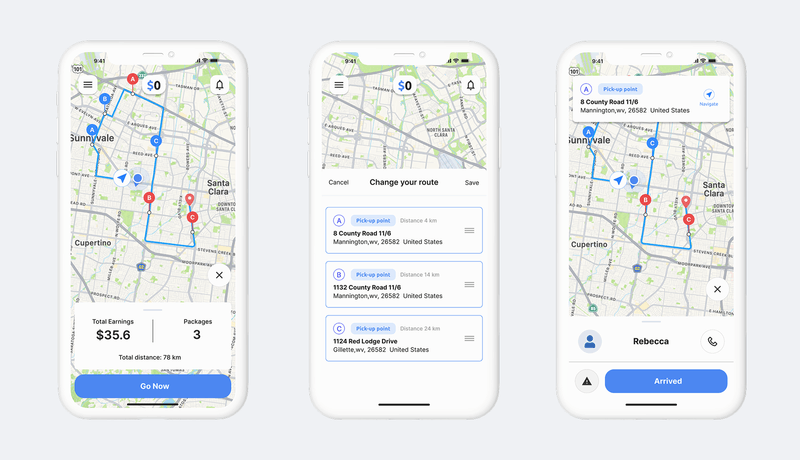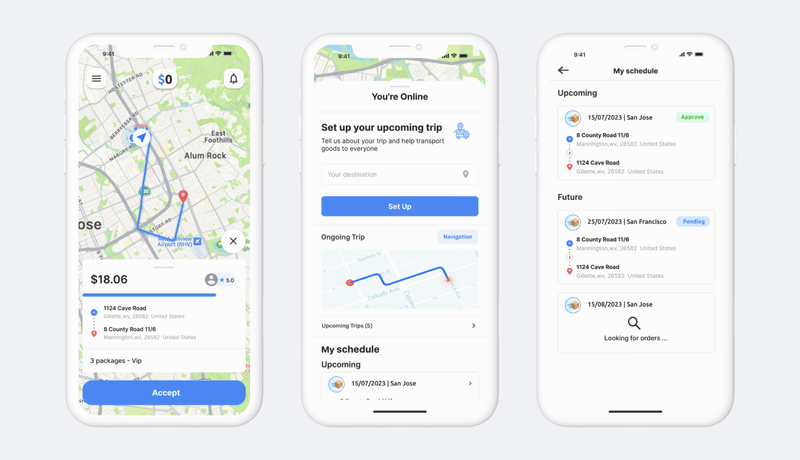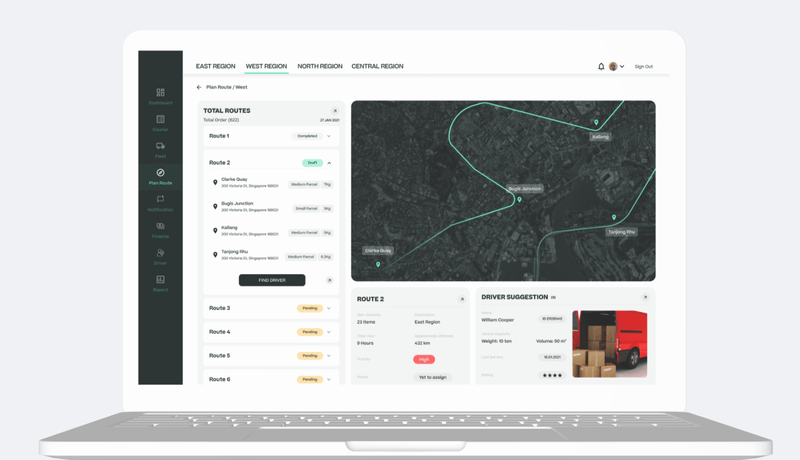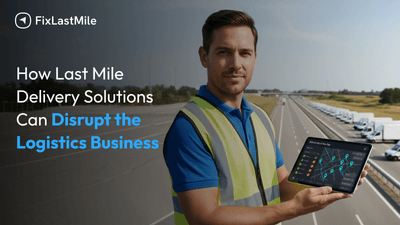When it comes to delivery operations, the last mile can make or break customer satisfaction.
Studies show that last mile delivery accounts for more than 50% of total shipping costs, making it the most expensive and complex part of logistics.
For businesses, it is not just about getting a package to the doorstep. It is about speed, accuracy, and customer trust.
This is where the right last mile delivery software comes in. It brings order to the chaos by automating processes, improving visibility, and ensuring on-time deliveries.
However, with so many options available, how do you choose the best fit for your business?
The answer lies in asking the right questions before you invest.
In this guide, we will walk you through the most important questions every business should ask before selecting a last mile solution. By the end, you will know exactly what to look for to build an efficient delivery system.
Why Choosing the Right Software Matters
The last mile is not just the final step in the delivery process. It is the moment that shapes your customer’s perception of your brand.
A single delay or failed delivery can lead to negative reviews, loss of trust, and increased costs.
That is why selecting the right last mile delivery software is no longer optional—it is essential for business success.
What Good Software Can Do
A reliable solution goes beyond basic delivery tracking. It incorporates route optimization software for delivery, reducing travel time and fuel costs while handling multiple stops efficiently.
It also offers real-time visibility, enabling customers and businesses to track deliveries at any given moment for full transparency.
The Cost of Making the Wrong Choice
Choosing the wrong software can create operational chaos, missed deadlines, and skyrocketing costs.
This is why businesses must evaluate features thoroughly before committing. Key functions like auto assignment for delivery and AI implementation in delivery software are critical. They help automate routine tasks, minimize human error, and boost overall efficiency.
Turning Challenges into Advantages
The right software does more than solving problems. It gives your business a competitive edge. But how do you find that perfect fit? The answer lies in asking the right questions.
Question 1 – Does the Software Offer Advanced Route Optimization?

Efficient routing can make or break your delivery operations. Before you commit to any last mile delivery software, ensure it offers advanced route optimization software for delivery that works in real-world conditions.
Now, let us break down why this feature is critical and what makes it a must-have in your delivery tech stack.
How It Works
Advanced route optimization considers multiple factors like traffic conditions, delivery windows, vehicle capacity, and distance.
The system then calculates the best possible route for drivers in real time. This not only ensures timely deliveries but also helps reduce fuel consumption and maintenance costs.
Benefits for Businesses and Customers
- Faster Deliveries – Reduce delivery times by selecting the quickest, most efficient routes.
- Lower Costs – Cut down on unnecessary fuel expenses and overtime charges.
- Happier Customers – Accurate ETAs mean better customer satisfaction and loyalty.
Why It Should Be Non-Negotiable
If the software you are considering does not offer advanced route optimization, it is a red flag. In today’s competitive market, you need a solution that improves speed and efficiency, not just basic tracking.
Question 2 – Does the Software Support Auto Assignment for Delivery?

Manual task allocation slows everything down. When scaling deliveries, you need auto assignment for delivery to automate dispatch and reduce errors. This is a feature you cannot ignore.
Let us see why auto assignment matters, how it works, and what it can do for your business.
Why Auto Assignment Matters
Assigning deliveries manually is time-consuming and prone to mistakes. Delays in allocation lead to missed ETAs and unhappy customers. Auto assignment for delivery eliminates manual work, speeds up dispatch, and ensures that every order reaches the right driver on time.
How It Works
Auto assignment uses smart algorithms to instantly match incoming delivery requests with the most suitable driver. It considers factors like driver availability, proximity, capacity, and performance scores. Once assigned, the driver gets notified in real time, ensuring zero delays.
Benefits for Businesses and Customers
- Faster Dispatching – Orders are allocated within seconds without human intervention.
- Higher Accuracy – Assigns to the best-fit driver based on availability and location.
- Better Efficiency – Reduces dispatcher workload and prevents double-booking or missed tasks.
Why It Should Be Non-Negotiable
If your last mile delivery software does not offer auto assignment for delivery, scaling will become a challenge. Automation is the backbone of modern logistics, and without it, you will struggle to compete in a fast-paced market.
Question 3 – Does the Software Include AI Implementation for Smarter Deliveries?

Modern logistics demands intelligence. AI implementation in delivery software helps predict delays, optimize routes, and improve accuracy. This is no longer optional; it is essential for growth.
Let us explore why AI matters, how it functions in delivery, and the real benefits for your business and customers.
Why AI Implementation Matters
The last mile is unpredictable—traffic jams, weather conditions, and fluctuating demand can disrupt delivery schedules. Traditional systems react, but AI-driven systems predict.
By using AI implementation in delivery software, businesses can make data-driven decisions to avoid delays, reduce costs, and enhance customer satisfaction.
How It Works
AI processes large volumes of data in real time, considering factors like traffic updates, historical delivery patterns, customer preferences, and weather conditions.
It then predicts the fastest routes, assigns drivers intelligently, and even suggests the best delivery windows to reduce failed attempts.
Benefits for Businesses and Customers
- Predictive Routing – AI forecasts delays and adjusts routes automatically.
- Smart Dispatching – Combines AI with auto assignment for delivery for accuracy.
- Enhanced Customer Experience – AI provides precise ETAs and proactive notifications.
Why It Should Be Non-Negotiable
Without AI implementation in delivery software, your operations are reactive, not proactive.
Competitors using AI will always deliver faster, smarter, and cheaper. If you want to scale and stay ahead, AI is not optional—it is critical.
Question 4 – Does It Provide Real-Time Fleet and Driver Tracking?
Visibility drives control. A robust last mile delivery software must offer real time fleet and driver tracking to ensure transparency, speed, and accountability in every delivery.
Let us break down why real-time tracking matters, how it works, and what benefits it brings to your business and your customers.
Why Real-Time Tracking Matters
Imagine not knowing where your drivers are or whether an order has reached the customer.
That lack of visibility can lead to delays, disputes, and dissatisfied customers. With real time fleet and driver tracking, businesses can monitor every movement, respond instantly to issues, and provide customers with accurate delivery updates.
How It Works
The last mile delivery system integrates GPS technology to track driver location on the map. It updates the dashboard in real time and syncs with customer-facing apps so that both dispatch teams and customers have live delivery updates.
Benefits for Businesses and Customers
- Fewer Delays – Identify route blockages instantly and reroute drivers quickly.
- Operational Control – Dispatch teams gain full visibility to manage multiple deliveries efficiently.
- Customer Trust – Real-time notifications keep customers informed and reduce delivery-related anxiety.
Why It Should Be Non-Negotiable
In 2025, customers expect to know where their order is at any moment. If your software lacks real time fleet and driver tracking, you risk losing customers to competitors who can provide that transparency.
Question 5 – Is the Software Scalable and Customizable?
Your delivery needs today will not be the same tomorrow. Businesses grow, customer demands evolve, and markets expand.
Choosing a last mile delivery software that is scalable and customizable ensures you are always ready for what is next.
Why Scalability and Customization Matter
As your order volume increases, the software must handle thousands of deliveries without performance issues.
At the same time, no two businesses are alike. Customization allows you to tweak workflows, add integrations, and create features that suit your unique needs.
How It Works
Scalable platforms use cloud infrastructure to adapt to high volumes without downtime.
Customization options may include branded customer apps, unique delivery workflows, and integrations with your existing ERP or CRM systems.
Benefits for Businesses and Customers
- Seamless Growth: Handle spikes in orders without service disruption.
- Brand Identity: Customize apps and portals to match your business branding.
- Operational Flexibility: Adapt the software to specific industry needs or regional compliance.
Why It Should Be Non-Negotiable
If the software does not scale with your growth or allow personalization, you will eventually hit a wall. A solution that offers flexibility today ensures long-term success tomorrow.
Question 6 – What Analytics and Reporting Does It Offer?
Data drives decisions. Without actionable insights, even the most advanced last mile delivery software can fall short. Analytics and reporting turn raw delivery data into strategies for growth.
Why Analytics and Reporting Matter
Detailed reports allow you to identify delays, optimize routes, measure driver performance, and track customer satisfaction. This is how you move from reactive fixes to proactive improvements.
How It Works
Modern delivery software collects real-time data on every delivery—from pickup times and ETAs to customer ratings.
These insights are presented in dashboards and downloadable reports so managers can make informed decisions quickly.
Benefits for Businesses and Customers
- Identify Bottlenecks: Spot delays and fix operational gaps.
- Optimize Routes and Costs: Use delivery data to fine-tune route optimization and resource allocation.
- Improve Customer Experience: Track satisfaction scores and implement changes for better service.
Why It Should Be Non-Negotiable
If the software does not offer robust analytics, you are essentially flying blind. In a competitive market, insights are your edge.
Final Thoughts
Choosing the right last mile delivery software is not about picking the cheapest or the most popular option.
It is about finding a solution that delivers scalability, automation, and actionable insights.
Features like route optimization, auto assignment for delivery, and AI implementation in delivery software are no longer optional—they are essentials.
If you are serious about improving your delivery operations, start by asking the right questions and evaluating the answers carefully. The right software will turn your delivery challenges into a competitive advantage.
Ready to optimize your last mile deliveries with smarter automation?




